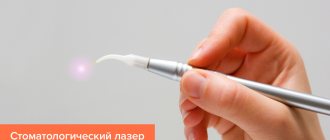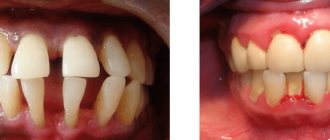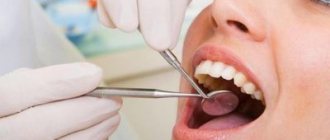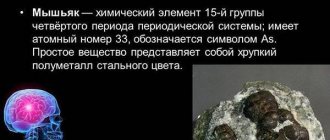Is it possible to put arsenic in a tooth?
Arsenic is a chemical element that belongs to immunotoxic substances, that is, poisons.
It disrupts the exchange of selenium, sulfur and phosphorus in tissues, which leads to a lack of oxygen, hypoxia and, as a result, cell death. In dentistry, it is not pure arsenic that is used, but a paste with arsenous acid anhydride in combination with various anesthetic and antiseptic components. Below, by arsenic we will mean a paste, and not a pure chemical element.
The toxin was first used for dental treatment in 1836. Nowadays, treatment methods have changed significantly, but in some cases dentists still use acid.
In the article Stom-Firms.ru we will tell you why arsenic is placed in the tooth during treatment. We will describe how and for how long it is placed, and also list the complications that may arise.
Harm of arsenic during dental treatment
Arsenic is a very strong toxin that should not be used thoughtlessly. When using the drug, there is a possibility of severe blackening of the tooth and swelling of the pulp, which only increases the pain. In addition, arsenic paste can cause drug-induced periodontitis, which is manifested by an inflammatory process in the periodontal tissues.
Taking into account such complications, the drug is used only in exceptional cases during pregnancy and up to 12 years, when the body is hypersensitive to any active substance. At the same time, it is quite difficult to calculate the dosage of the medication for patients in these groups, since the existing dose is designed exclusively for adult patients without serious pathologies in the body.
Swelling of the remote control is one of the possible complications of arsenic ingestion
Also, patients often complained of the following side effects; in some cases, symptomatic treatment was required:
| Sign | Frequency of occurrence |
| Pain in adjacent teeth and gums | Often |
| Headache | Often |
| Jaw pain | Often |
| Nausea | Rarely |
| Increased body temperature | Sometimes |
| Vomit | Often |
- Why is there arsenic in the tooth?
Attention! If arsenic is used excessively or if there is a strong sensitivity to it, the dangerous condition of osteonecrosis can develop. This is the name of the disease when the tissues of the periosteum and bone begin to die.
Indications and contraindications for the use of arsenic
Arsenic acid is used for devitalization, that is, killing the dental pulp in order to then partially or completely remove it. Before the development of anesthesia, this was the only way in which it was possible to remove a tooth relatively painlessly, cure pulpitis and some other dental diseases.
Now the pulp is removed under local anesthesia and using drugs without arsenic. But there are indications according to which he is still placed. These include:
- Acute diffuse or chronic fibrous pulpitis;
- Chronic hypertrophic pulpitis in teeth with impassable and curved canals;
- Allergy to local anesthetics;
- Severe general condition, for example, after a heart attack or stroke;
- Inability to open the mouth wide due to contraction of the lower jaw.
Dentists emphasize that arsenic is not an alternative to pulp removal with anesthesia. The toxin is used as a last resort when the patient has indications for it.
Arsenic should not be placed in the dental cavity if:
- Allergies to paste components;
- Pregnancy and lactation;
- Increased eye pressure;
- Diseases of the urinary system;
- Unformed roots.
In pediatric dentistry, arsenic should not be administered to children under 1.5 years of age. But today, paste with arsenic acid is practically not used to treat pulpitis in a child. Pulp devitalization is carried out with other drugs.
Indications for using arsenic for a sore tooth
In most cases, the doctor turns to arsenic paste for help in the following situations:
- intolerance or allergy to anesthetic used in dentistry;
- poor tolerability of treatment even with the use of painkillers;
- urgent indications for the patient, most often when visiting the doctor on duty, when it is not possible to use a paid good pain reliever;
- lack of effect from the therapeutic dosage of the anesthetic, increasing its amount is dangerous, as it can provoke anaphylactic shock, in which case the paste will have the necessary effect;
- inability to use an anesthetic drug due to the patient’s medical history, usually with serious kidney and liver diseases;
- the patient’s fear of injections, usually in childhood or with excessive nervous excitement;
Arsenic is added when there is no effect from the therapeutic dosage of anesthetic
Attention! Before administering the medicine, you should make sure that the patient feels well. Sometimes poor condition, especially fever and nausea, can cause more severe intoxication of the body, since arsenic will only worsen the patient’s health.
How to put arsenic in a tooth
Depending on the age of the patient, the condition of the pulp and the size of the tooth, the doctor determines how much paste is needed. Typically, its amount varies from 0.0002 to 0.0004 mg.
Let us describe the stages of the procedure:
- The dentist uses an excavator to remove food debris, damaged tissue and thinned dentin from the carious cavity;
- A ball-shaped paste is placed on the pulp horn and covered with a bandage;
- Hermetically seals the cavity with a temporary filling.
Sometimes doctors put the paste on the unopened pulp. Then, after the procedure, the tooth may be very painful, especially when pressed, because swelling occurs and pressure in the tissues increases.
Usually, adults put arsenic in single-rooted teeth for 24 hours, in multi-rooted teeth for 2 days, but this period can increase to 6 days depending on the manufacturer and brand of the drug. Then the patient comes back for an appointment, and his pulpitis is treated in the traditional way: the temporary filling is removed, the cavity is prepared, the pulp is removed or amputated, the canals are processed and sealed.
Tooth removal
Depulpation (depulpation of a tooth) is the removal of pulp, connective tissue consisting of blood vessels and nerve endings. Removing the tooth nerve and cleaning the canals is designed to relieve the patient from pain, inflammation and further complications. However, the tooth, having lost its blood supply, becomes dead and, therefore, more fragile.
Dental treatment and nerve removal is one of the most common dental procedures. This is partly because patients turn to the dentist only in case of unbearable pain, when it is no longer possible to do without depulpation. Removing the nerve of the tooth and filling the canals allows you to preserve the natural tooth, which is a priority for endodontic treatment.
Indications for depulpation:
- extensive caries
- classic pulpitis and infectious pulpitis (bacteria penetrate through the root apex)
- trauma and damage to the tooth affecting the pulp
- if it is necessary to install crowns or classic bridges
Many patients who come to the dentist's office with toothache are interested in the question: is it possible to save the pulp? Today, there are methods of biological treatment (preservation of the entire pulp) and vital amputation (preservation of the root pulp), but many favorable factors must converge for them to be carried out. For example, biological treatment is not carried out after 25 years.
What to do if complications arise when using arsenic
If the doctor correctly selected the dosage and hermetically installed the temporary filling, and the patient came for a follow-up appointment on time, there will be no complications after using the paste. They occur if the therapist used too much of the substance, did not install the filling tightly and it fell out, or when the patient missed the deadline for taking it and walks with arsenic longer than expected.
The most common complications include:
- Burn of the mucous membrane, for example, gums;
- Necrosis of surrounding tissues and pulp of adjacent teeth;
- Arsenic periodontitis and periodontitis;
- Osteonecrosis is the destruction of jaw bone cells.
If arsenic falls out, the patient has a headache, feels sick and vomits, contact the clinic immediately. When the poison enters the body, the doctor administers an antidote. In case of damage to the mucous membrane, treat the affected area with antiseptics and drugs that block the spread of the toxin and accelerate tissue epithelization.
In modern dentistry, to avoid overdose, the paste is produced in special granules. The main thing that doctors urge is not to overexpose arsenic: keep it for as long as you are prescribed to walk with it. Then the risk of complications becomes minimal.
How to clean
This manipulation should be approached with all responsibility. All rules must be followed so as not to cause harm. It is very important to pay attention to disinfection. The workplace should be well lit. If there are someone close to you, then it is better to enlist their help. If there is no one, then you can simply arm yourself with a mirror.
Procedure algorithm:
- Brush your teeth, remove plaque.
- Wash your hands using an antibacterial product.
- Select the tool that you plan to use to extract arsenic. It could be a syringe, a sewing needle or any other. Wipe it with a solution of potassium permanganate or alcohol.
- Using smooth and careful movements, remove the upper part of the soft filling material. We must try to act in such a way as not to violate the integrity of the substance. Don't go too deep to avoid damaging your gums. The extracted gray pulp is immediately pulled out of the mouth. If you accidentally swallow it, it can cause serious consequences.
After the manipulation is completed, it is recommended to rinse your mouth with a soda solution or chamomile decoction. Apply sterile gauze to the tooth, which will act as a barrier between the dead nerve and the food. It is advisable to visit a doctor on the same day so that he can install a filling.
More information on the topic
When they use arsenic and why, you will learn even more in the articles:
- Deep caries
- Treatment of periodontitis
- Dental prosthetics
References for the article:
- Kostina I.N., Nikolaeva A.A. “Arsenic necrosis of the jaw - complications in the treatment of dental pulpitis” // “Problems of Dentistry” No. 3, 2010.
- "Endodontics. Pulp diseases" // Textbook / A.S. Opravin et al. – Arkhangelsk: Publishing House of the Northern State Medical University, 2016.
How can you get rid of arsenic without a doctor?
Doing such things is, of course, not recommended. But in situations where, for certain reasons, a trip to the doctor is postponed, you can remove the arsenic paste yourself. To do this, you need to thoroughly clean the oral cavity with a paste, use a balm rinse, and then a weak solution of potassium permanganate. Hands also need to be treated with any antiseptic.
After this, using a sterile needle, if you don’t have one, simply disinfect the sewing needle in a concentrated solution of potassium permanganate, iodine or alcohol, and carefully crumble the temporary filling. It is very soft, so it gives in easily. It is important not to touch the filling or go deeper into the pulp of the tooth. Arsenic is gray in color, it should be carefully picked up with a needle and pulled out, do not swallow it under any circumstances. After this, the oral cavity is again treated with an antiseptic, and the diseased tooth is filled with a sterile swab or cotton wool.
When there is really no way to contact even the doctor on duty, you can remove arsenic yourself
Attention! This should be done in exceptional cases, when there is really no way to even contact the doctor on duty. Independent manipulations can significantly complicate the patient’s condition.
Many doctors are already refusing arsenic paste, citing its danger to the body if accidentally ingested. Also, doctors are forced to take such measures by the patients themselves, who do not always come to the doctor on time after laying arsenic, which causes quite strong side effects and inflammatory processes. Dentists with extensive experience are sure that it is better to pay a little extra money for a modern anesthetic, they are produced in Germany, Japan and the USA, and immediately carry out all the necessary manipulations with a diseased tooth. This will significantly save time and reduce the risk to the patient’s health.











